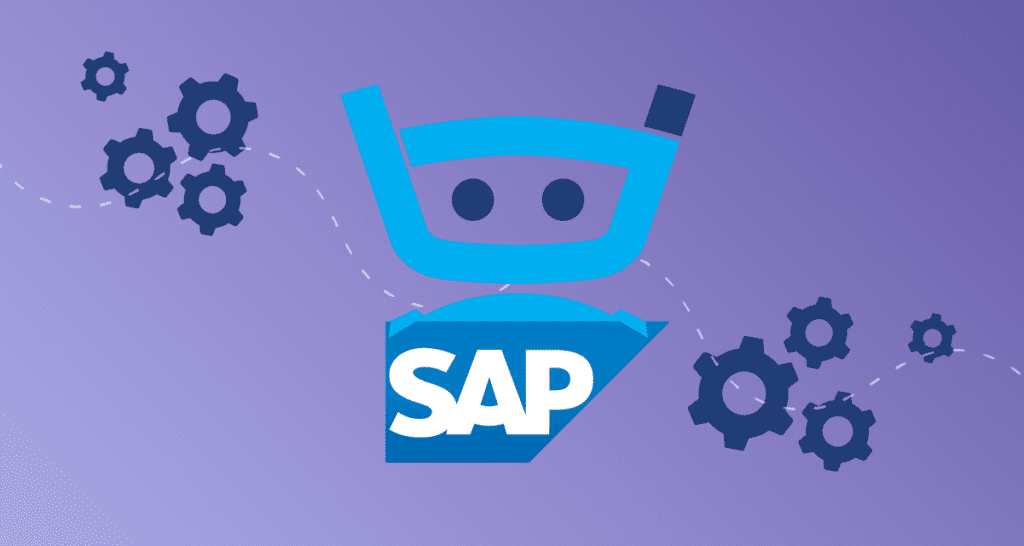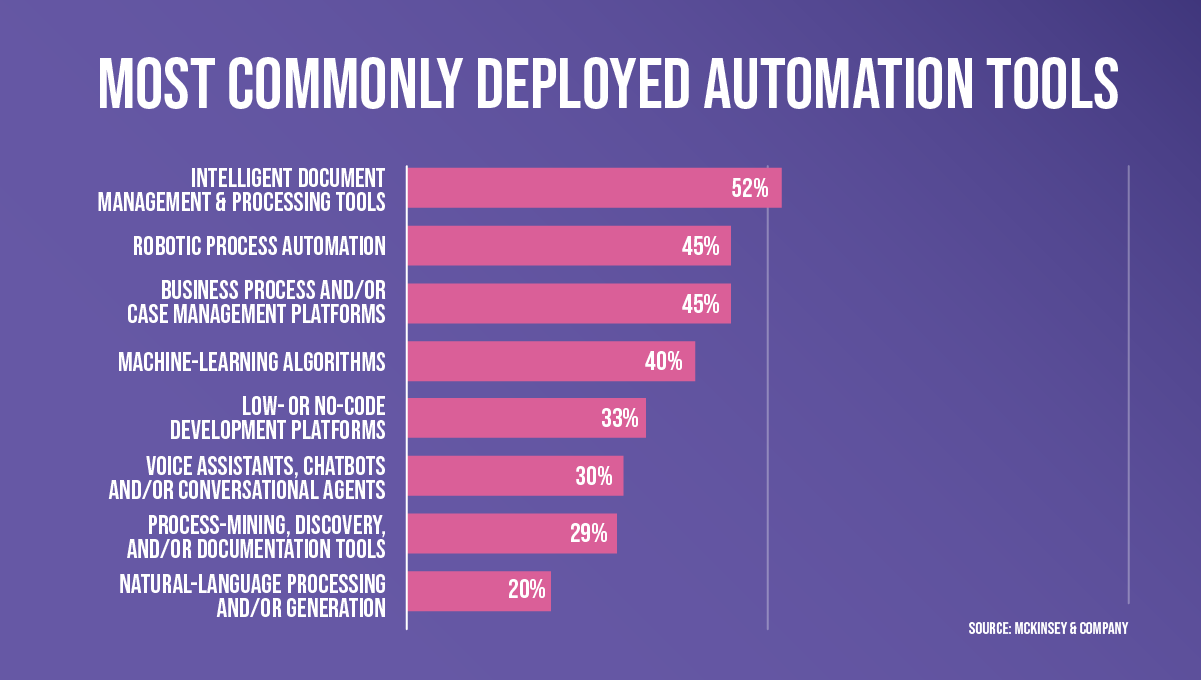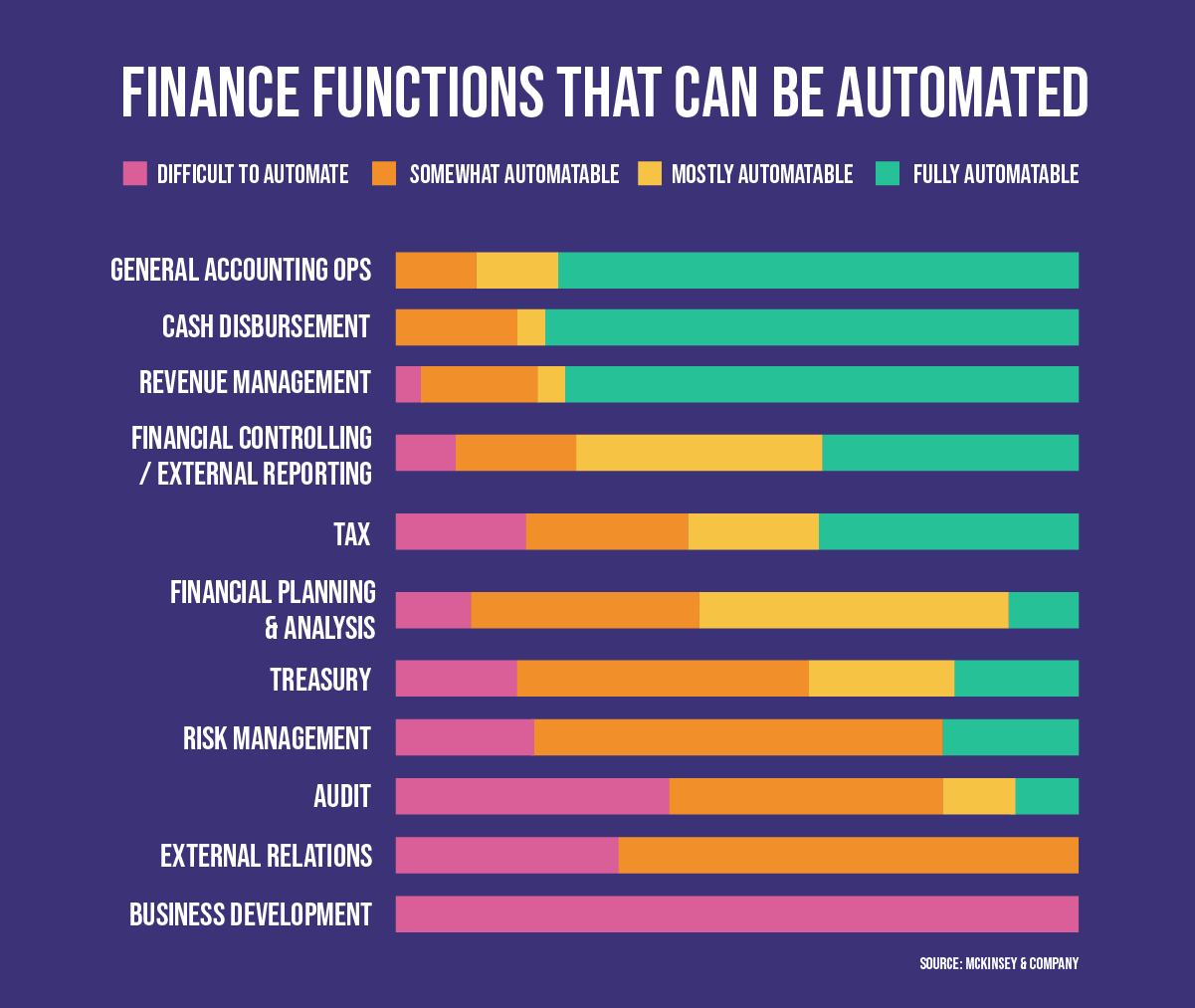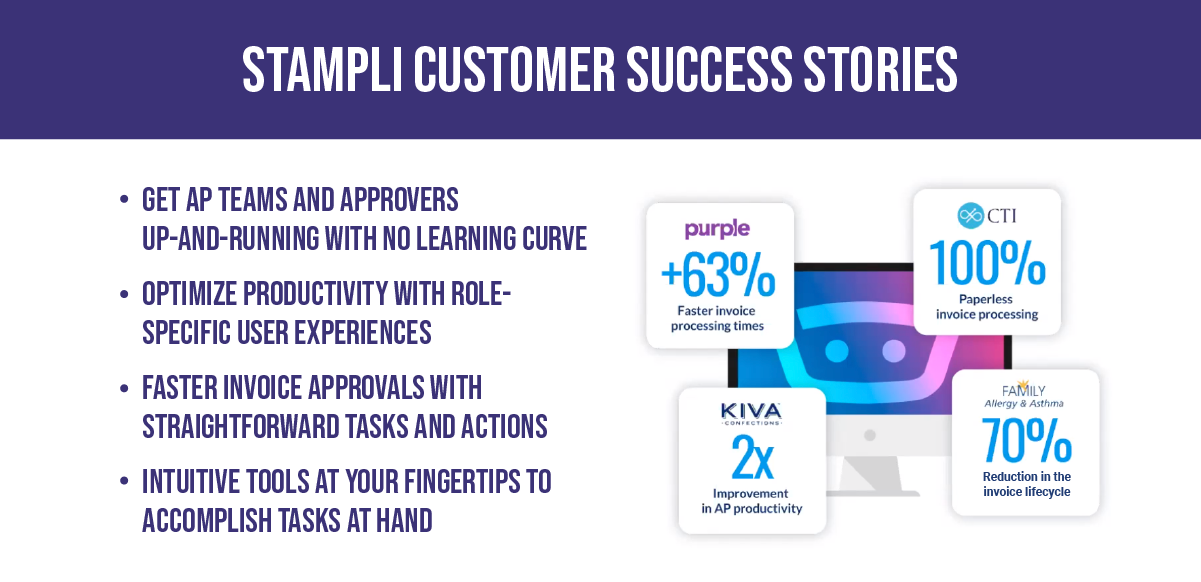SAP automation ideas: Get the most out of your ERP

Many business processes involve manual and repetitive tasks that are tedious, time-consuming, and error-prone. Whether it’s data collection, document processing, or financial operations, these monotonous tasks are great candidates for automation – freeing employees to work on higher-value projects.
Powerful and customizable ERPs and third-party integrations are ideal for automating business processes. If you use SAP ERP to manage your company’s operations, you may be considering how to automate currently manual and repetitive finance and business processes for SAP.
Let’s look at the benefits of automating business processes within the SAP ecosystem, the basics of SAP process automation, and the best ways to automate accounts payable processes in SAP.
Benefits of SAP process automation
In Ep. 26 of the Leaders of Modern Finance podcast, Ryan Myers, CFO at America’s Thrift Stores, discusses the challenges of building better financial systems and relationships. Ryan learned that using good information to maximize efficiency is the foundation of building successful financial systems.
While SAP’s out-of-the-box configuration necessitates that finance personnel frequently create custom views to enable departments like AP to access reports within the ERP system, automation through a third-party application can provide readily accessible reports with built-in analytics and access to actionable business data.
For example, a third-party application can automate finance functions for SAP software lets your business access key metrics and make informed decisions based on good data. Customers say automation in SAP “is helping organizations by redesigning processes and leveraging data as the driving force for automation and decision making, while also helping to ensure that software can integrate effortlessly with third-party applications.”
Here are the key benefits of automation:
Fast access to data builds business agility
Automation lets you access your business data across ERP modules and third-party integrations. Having access to timely and accurate data in SAP reduces time to action and lets businesses anticipate change and plan growth.
Scalability for growth
Automations are scalable, which is valuable for performing more tasks in your business. You can do more and process more data, which lets you easily scale to big data volumes.
Stay compliant
By automating finance processes, you can stay compliant with data governance and regulatory standards. Automation ensures tasks are performed exactly as they should be, avoiding costly mistakes.
Improved employee engagement and productivity
Nobody wants to do the same monotonous, repetitive tasks every day. Automation lets employees dedicate their time and energy to more engaging, higher-value activities.
Better customer satisfaction
Automation improves responsiveness and customer satisfaction by speeding up and reducing the inefficiency of your customer-facing business processes and SAP applications.
Optimized business processes
Automating your workflows and processes reduces the time (and cost) of manual processes. However, as we’ll explore later, SAP’s complexity and rigid organizational structure can limit the value of its automation features. You can maximize efficiency by pairing SAP 3rd party integrations (like Stampli) that automate specific business processes like accounts payable.
The benefits of automating business processes for SAP are compelling. Fortunately, businesses have plenty of options when it comes to SAP automation.
How to automate processes in SAP
SAP has comprehensive automation capabilities for your business. You can choose one of SAP’s automation tools, such as SAP Build Process Automation, SAP or third-party Robotic Process Automation (RPA), or Workflow Management solutions. You can also select one of the numerous third-party SAP integrations to automate specific processes and functions like payroll, accounts payable, and accounts receivable.
With this in mind, here’s an overview of the main ways to automate processes for SAP:
SAP Build Process Automation
In 2022, SAP launched Build Process Automation, a bundle of low-code/no-code tools for automating business processes within SAP. Build Process Automation combines workflow management, RPA, AI/ML capabilities, and pre-build functionality, business rules, and templates to allow business users to automate processes and workflows. The solution promises to simplify creating and deploying process automation with minimal SAP Basis involvement or ABAP coding. Build Process Automation supports extensions of processes from SAP HANA, S4/HANA, SAP Ariba solutions, and SAP ERP.
Robotic Process Automation (RPA)
RPA helps businesses automate repetitive manual tasks by engaging a software robot, or bot, to mimic end-user interactions with business systems. For example, RPA can be used to search for specific text in Excel and then copy and paste the text into another app. RPA can also be used to automate manual data transfers from legacy systems that lack integration with SAP. Although RPA solutions may require coding, some providers offer no or low-code solutions such as pre-built best practice bots.
Workflow management tools
Workflow management tools digitize workflows and manage decision logic to optimize workflow efficiency. These tools can include functionality such as workload automation (WLA) to schedule, execute, and monitor optimized workflows across SAP applications.

Third-party applications and integrations
Although SAP is a powerful business tool, it is also very complex — potentially making process automation difficult. Automated processes and customizing workflows for SAP requires significant IT support or the use of outside consultants. SAP ERPs also have established organizational structures for workflows and controlling access through user roles, further adding to the difficulty of developing customized automation workflows.
Purpose-built third-party applications (such as Stampli) automate specific business functions such as CRM, HR, payroll, accounts payable, or accounts receivable. These solutions provide less complexity, more flexibility, and deeper functionality than SAP modules. They also have the advantage of being platform-independent, a bonus for companies using multiple ERPs.
Now that we have a basic understanding of how we can automate processes for SAP, we can look at a few common use cases for automation.
Use cases for SAP process automation
Companies can use process automation for almost any manual, rule-based workflow in the SAP system. Here are some of the use cases for automation that other companies have implemented via SAP or third-party integrations.
Human resources
Automation can streamline many HR processes, particularly recruiting. You can automate the placement of job postings, candidate outreach (searching resources and databases for qualified candidates), application entry and tracking, the interview process, and job offer creation. For example, you can use an automated chatbot to engage with and screen candidates during the interview process.
Monitoring SAP interfaces and connections
SAP ERP systems need to be integrated with different SAP and third-party systems. Integration is done through interfaces via SAP Process Integration and SAP Process Orchestration. These interfaces process a high volume of transactions daily, and IT departments don’t always detect errors when they happen. Also, it can take IT teams a long time to find and fix the problem when an error occurs. RPA or workload automation (WLA) tools can automatically monitor your interfaces and quickly detect and fix errors. Some third-party integrations are less difficult to manage. For example, in Stampli, all ABAP programs are pre-built and customized so no SAP technical resources are needed. Stampli also doesn’t require BAPI access, keeping your system secure and protected.
Supply chain management
You can use automation to streamline procurement, master data, and logistics processes across your global supply chain. For example, you can automate tasks like maintaining vendor records and documents, contract management and tracking, preparing shipment schedules, tracking shipments, inventory management, and reporting.
Finance and accounting
SAP finance modules streamline financial processes, provide financial data, and enable up-to-date financial insights and reporting. You can automate many finance and accounting tasks in SAP, such as:
Accounts receivable (AR)
You can automate many steps in the AR order management process, such as order placement, order information recording, order fulfillment and delivery, and order entry. For example, you can use automated order management tools such as self-service ordering or document data extraction to reduce errors in order data collection.

Account reconciliation
You can use automation tools to streamline the manual process of matching your general ledger entries against bank statements. Automation also reduces the possibility of human error and makes it much easier to detect fraud.
Treasury
You can use RPA bots in SAP to automate cash positioning and extract reports from the financial statements to analyze cash flow and financial risks from KPIs, reports, and liquidity plans.
Accounts payable (AP)
AP processes, like document capture, data entry and coding, invoice verification, approvals, vendor management, expenses, and payments, can be automated for SAP with SAP modules or third-party integrations like Stampli. While SAP represents a tried-and-true method of AP processing, third-party AP solutions represent an evolution in accounts payable. For example, Stampli leverages AI and machine learning to learn AP processes, boost processing speed, and improve working capital management.
Next Steps: how to plan for automation in SAP
To automate processes in SAP, you need to start with a top-down assessment of your existing workflows and needs within SAP and across your business. This assessment will help you identify which business processes are the best candidates for automation and decide which automation tools you should use.
As part of your assessment, evaluate the ROI of each SAP automation tool -– taking into account the direct and indirect business benefits and costs and the strategic value of automating key functions. For example, automating accounts payable has many direct benefits, such as reduced processing time, costs, and errors. It also has indirect benefits like increased insight into transactions, reduced fraud, and improved vendor relationships.
While enterprises choose SAP for its power and capability the platform does have drawbacks that can limit its effectiveness in automating processes.
Stampli – empower SAP with the leading AP solution
A major factor in implementing any automation within SAP is complexity. For example, SAP segregates related functions into separate sections, complicating navigation and workflow design. Although their core functionality may be straightforward, many SAP automation solutions can be very difficult for customers to implement. “One of the things that I dislike about SAP S/4HANA Cloud is the steep learning curve,” commented one SAP user. “Sometimes it can be challenging to navigate through the different features and configurations.”
AP processing in SAP is slow, complicated, and frustrating, but Stampli makes processing fast through its intuitive design and powerful capabilities. “I appreciate how Stampli’s superior automation has streamlined and fully automated AP processing,” says a Stampli customer on Capterra. “I enjoy Stampli’s search and filter capabilities, which allow us to search numerous databases and retrieve the invoices we need, and the convenience of editing fields and exporting and importing reports.”
A TrustRadius reviewer concurred by mentioning the need for extensive IT resources to learn and implement SAP. “For use cases where the company is not mature from an IT perspective, I would not recommend it,” and concluded, “The overall complexity shouldn’t be underestimated.”
Finally, a reviewer on G2 suggested that automating processes with SAP may not provide the best ROI for businesses, stating that, “Implementing and Maintaining S/4 HANA Cloud can be expensive and total cost of ownership may be a concern for some [organizations].” They highlighted the inflexibility of SAP’s rigid organization structure, saying it “can be a concern for [organizations] with highly specific or unique business processes that may not align perfect[ly] with the standard features of S/4HANA.”
While automating workflows in SAP can be a notoriously complex process, customers praised the adaptability and simplicity of Stampli’s dynamic workflows. “Stampli automated a workflow for us that had previously become an excessive waste of time for an otherwise simple process,” says a Stampli customer on G2. “As a national company, it helped integrate our teams around accuracy, timing, and process for approvals. Being able to pre-program the workflows make us less error prone, and I especially love how it tracks issues across a period of time for all of the different filters that allow me to narrow in on issues.”
Stampli for SAP makes AP automation easy — great news for companies struggling with complicated AP processes in SAP. “We have been a happy customer since 2017,” said a happy Stampli customer on G2 “Stampli is integrated with our ERP system adding AI (Billy) and automation to our billing process easily adding 5-10 hours back to our week…
Stampli’s flexibility has allowed us to create the best workflow for our company.”
Many enterprises manage AP processes by a combination of manual and digital methods. Automating these processes in an ERP can be challenging as many ERPs are not designed for invoice processing or lack AP-specific automation features. For example, some ERPs handle invoices and expenses differently based on whether they are supported by purchase orders or not, which can complicate invoice processing workflows. Other systems require the creation of tailored views so AP teams can access and interact with AP-specific financial reports.
While automating workflows in SAP can be a notoriously complex process, customers praised the adaptability and simplicity of Stampli’s dynamic workflows. “Stampli automated a workflow for us that had previously become an excessive waste of time for an otherwise simple process,” says a Stampli customer on G2. “As a national company, it helped integrate our teams around accuracy, timing, and process for approvals. Being able to pre-program the workflows make us less error prone, and I especially love how it tracks issues across a period of time for all of the different filters that allow me to narrow in on issues.”
Stampli for SAP is the smartest and fastest accounts payable solution. It’s for accounts payable teams that want the efficiency of automation but don’t want to rework their ERP or change their existing AP processes. Stampli supports all native functionality for more than 70 ERPs, including Sage Intacct, Microsoft Dynamics Business Central, SAP S/4HANA, Oracle NetSuite, QuickBooks Online, and 70 others, enabling it to deploy faster than other AP solutions.
By providing a simple, filterable view of invoices, bills, and expense types, Stampli for SAP provides complete visibility and control over your SAP accounts payable program. It lets AP teams share GL accounts, vendor information, and custom fields between Stampli and SAP to reduce the risk of errors, fraud, and compliance issues, improve vendor relationships, and make your AP processes much more efficient.
Stampli is simple for users to learn and even simpler to use, especially with Billy the Bot™ automating nearly all your capture, coding, routing, fraud detection, and other manual tasks. For even greater efficiency, Stampli’s core AP solution is complemented by a suite of integrated products that include Direct Pay, Credit Cards, Advanced Vendor Management, and others.

How Stampli makes you successful
Here’s how the only AP solution purpose-built for Accounts Payable will make you successful.
- Dynamic workflows with Billy the Bot™: Stampli’s advanced AI assistant learns your workflows and adapts to process changes to eliminate manual work in your SAP ERP.
- Multi-subsidiary support: Process and pay invoices across companies, offices, departments, or locations in a single place.
- Centralized communications: Stampli simplifies collaboration and ensures accountability and context by putting all messages in one place.
- Actionable insights: Stampli provides real-time AP reports with built-in analytics, eliminating the need to build custom reports in your ERP.
Take control of SAP accounts payable automation today. Contact Stampli for a free demo.
